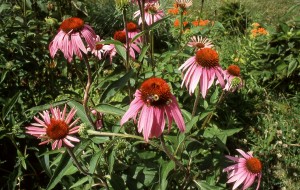Purple cone-flower also known as Echinacea was once at risk as an endangered plant. It was over harvested in the wild and some states took action to protect the remaining Echinacea also know as purple cone-flower.Today we are growing these purple daisy like flowers in our gardens and perennial herbaceous border.
Purple cone-flower or echinacea has widespread medicinal applications. The Native Americans used Echinacea to treat all kinds of ailments such as snakebites, fevers, colds, and influenza. They used the roots for their painkilling and blood purifier properties. Native Americans were the first to discover the root had the most medicinal properties.
In the 1920’s it became popular by practitioners and was widely prescribed, but when antibiotics was introduced Echinacea was all but forgotten. With the over use of antibodies, today’s herbalists have popularized the herb again. Echinacea is now found in most herbal first aid kits and can be purchase in most health food stores, including the big box stores.
Millions of Americans and Europeans use purple cone-flower as their main go to for colds and flues. It is known for its antibiotic qualities and general immune boosting effects.
Purple cone-flowers well known species include: Echinacea purpurea, E. pallida, and E. angustifolia. All three can be grown in our garden and in some states pallida is a native.
Parts used: The whole plant which includes the root, flowers, leaves, and seed.
Site: Its native habitat of prairies is found from Texas to southern Canada. E purpurea likes a richer soil with rock phosphate and compost in the soil. E. angustifolia and pallida like a leaner soil with less water. Pallida is not as showy or tall as E. purpurea. The growing zones for purple cone flower or echinacea is 3-9 and likes full sun to part shade.
Blooms: E. purpurea has a bright pink flower with a hairy stem and will bloom from mid to late summer. The more water it receives, the longer the blooms. E. pallida has paler pink flowers, fewer leaves and is not as tall. Purple cone-flower’s stunning flowers make a wonderful border plant for any size garden. Purpurea has a slight honey like scent.
Growing: Perennial. Purple cone-flower will grow from seed with about 50% germination. It needs a cold period for about 3 months. Sew the seeds in the fall or indoors in very early spring with stratified (exposed to cold) seeds. Echinacea is slow to grow and may take several months to reach a size to transplant in the garden. The seeds take about 2 to 6 weeks to germinate. Purple cone-flower likes to grow in clumps, so plant about a foot apart. It can be divided or grown from root cuttings.
Harvest: Roots should be about three years old before harvesting. Any sooner and the roots are too small to harvest. Pallida and angustifolia have fibrous roots and are easier to harvest, but unless you are growing these in your own garden, please be aware of the laws of harvesting in the wild. Your neighbors may allow you to harvest, but ask first.
Properties: Bitter and slightly aromatic, antibacterial and antiviral. Cool, dry and pungent.
Primary medicinal uses: Immune system function, colds, flues, minor infections, wounds, psoriasis, eczema, Echinacea is being study in aids therapy, digestion, fungal infections, blood poisoning, boils, abscesses, respiratory tract, and venereal diseases.
Cautions: Few if any, mostly extreme use can cause throat irritation. Autoimmune suffers should check with their health care professional. Echinacea, if strong enough, will numb the tongue.
Applications: Root (decoction) tinctures, wash, gargle, powdered, capsules, syrups, compress, poultice, lozenges, infused oil, and liniments. The leaf and flower can be used in the same applications as the root except the leaf and flower should be brewed as an infusion.
Decoction is used for bark and roots. Place roots in simmering water for 10 minutes and strain.
An infusion is for the soft parts of the plant. Take boiling water off heat and allow to cool one minute and pour over leaves and steep for 2-5 minutes. Delicate leaves and flowers should be steeped for about one minute.
All medicinal information is for your information and not intended as medical advice.
Happy gardening!

